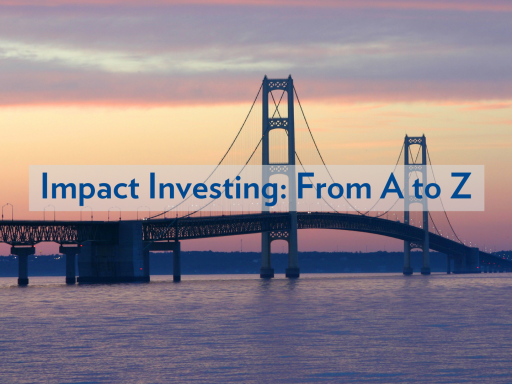Lessons Learned from BioPharma
While corporate foundations have not been as quick to adopt impact investing there are a growing number of examples we can look to.
While corporate foundations have not been as quick to adopt impact investing there are a growing number of examples we can look to.

By Jennifer Oertel, CMF Impact Investing Expert in Residence
It could be argued that corporate foundations and corporate giving programs are among the most well poised of all foundations to conduct impact investing given their wealth of resources (e.g., in-house legal) and acumen in both business and philanthropy.
While corporate foundations nationwide have not been as quick to adopt impact investing as a tool for their philanthropy, there are a growing number of examples we can look to for lessons learned for our own growth.
The business journal Life Science Leader recently described the impact investing journey of two biopharmaceutical companies, and while the nature of their work may be very different from our own, their focus on partnership, efforts to align with the UN Sustainable Development Goals (SDGs) and infrastructure efforts to address matters of governance give us plenty of insights to apply to our foundation roles, in corporate philanthropy and beyond.
In his piece for the Leader, Chief Editor Rob Wright first describes the impact investing story that began about five years ago for Merck (also known as MSD). Observing the growing corporate interest in impact investing within the healthcare industry, Merck reached out to the United Nations to explore private sector contributions to social issues, including attainment of the SDGs. As Wright highlights, partnership is a key focus of the SDGs, and it was Merck’s convening of various members of the ecosystem that led to a connection with the Global Impact Investing Network (GIIN), a hub for investors and investment vehicles which has been prominently featured in CMF’s impact investing resources and past communications.
Through conversation with GIIN and others, Merck came to view impact investing as another way by which to express corporate social responsibility (CSR), but in a way that will provide a return of, or a return on, its funds in order to be re-deployed to support and sustain other CSR initiatives, giving them “a second bite at the apple” according to Merck’s chief of staff and strategy officer for social business innovation.
In the graphic below (Table 1), we see the scorecard Merck developed for reviewing impact-investment opportunities. The scorecard is a tool used by the company’s impact investing committee to evaluate each opportunity after completing a due diligence process. The tool is one CMF members may find highly valuable, particularly because of the balance of financial and social criteria that are considered.

For Johnson & Johnson (J&J), an impact investment “aha” moment came during the company’s participation in a meeting of the G8* Social Impact Investment Task Force, according to former J&J executive Jane Griffiths, Ph.D.
Griffiths describes how stakeholders conveyed that impact investing in healthcare was more “nascent” and less developed than some other sectors (like microfinance and agriculture), but that the company’s scientific knowledge around health as well as other corporate expertise was a unique value-add that could help further impact investing in healthcare.
“If you know how impact investing works, it’s not just about investing money, but time, energy and mentorship for the benefit of the outcome you are trying to achieve,” she shared with Wright.
J&J has since made a series of impact investments, as set forth below in Table 2. Like Merck, J&J also vets its potential impact investments in terms of the UN’s SDGs and establishes metrics for evaluating whether those goals are achieved, while keeping top-of-mind the opinion that investors should not burden investees with inappropriately detailed metrics that may be difficult to capture.

Griffiths goes on in the article to share other key tips for organizations exploring impact investing for themselves, including why not every startup investment goes as planned, and the importance of proactively addressing questions about the basics of impact investing among internal stakeholders.
I hope you enjoy the article and that it catalyzes discussion within your organization.
As a last thought, I will leave you with the following recommendations from the G8 Social Impact Investment Task Force, which aims in part to explore how impact investing can accelerate economic growth and solve the world’s most pressing social challenges.
Set measurable impact objectives and track their achievement.
Investors should consider three dimensions: risk, return, and impact.
Clarify fiduciary responsibilities of trustees: to allow trustees to consider social as well as financial return on their investments.
Pay-for-success commissioning: governments should consider streamlining pay-for-success arrangements such as social-impact bonds and adapting national ecosystems to support impact investment.
Consider setting up an impact-investment wholesaler funded with unclaimed assets to drive development of the impact investment sector.
Boost social-sector organizational capacity: governments and foundations to consider establishing capacity-building grants programs.
Give profit-with-purpose businesses the ability to lock-in mission: governments to provide appropriate legal forms or provisions for entrepreneurs and investors who wish to secure social mission into the future.
Support impact investment’s role in international development: governments to consider providing their development finance institutions with flexibility to increase impact investment efforts. Explore creation of an “impact finance facility” to help attract early-stage capital, and a “development impact bond (DIB) social outcomes fund” to pay for successful DIBs.